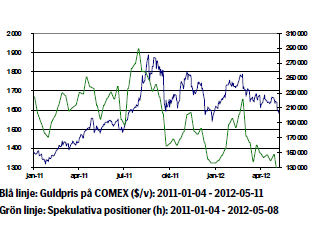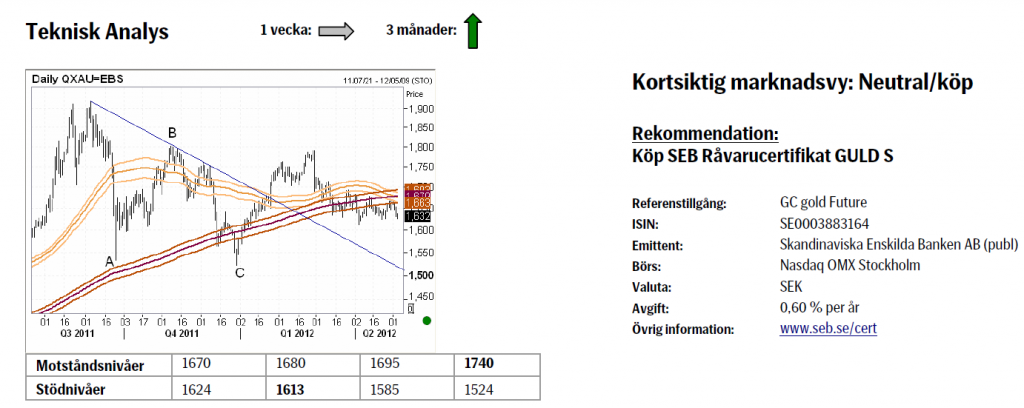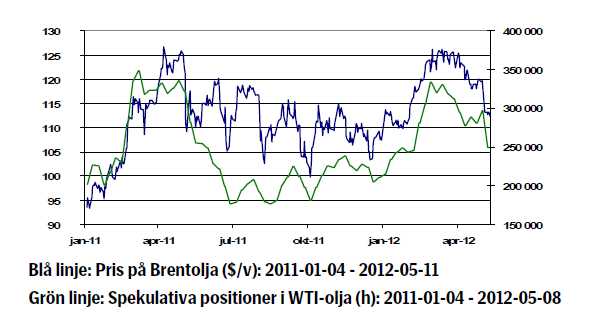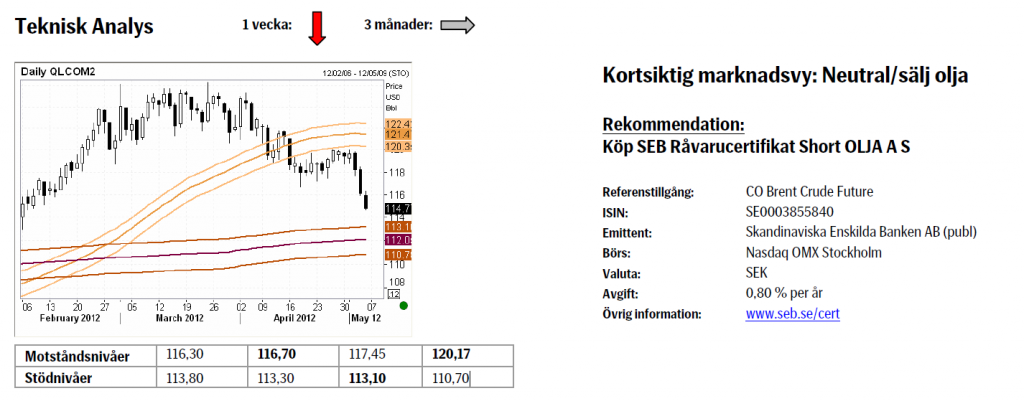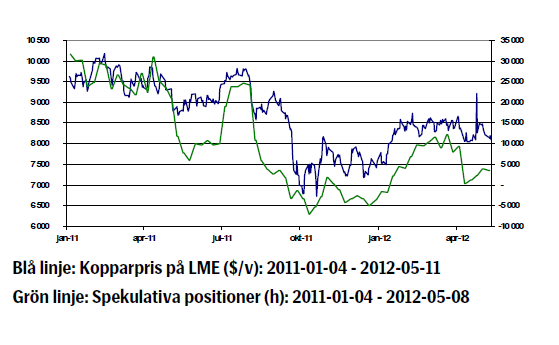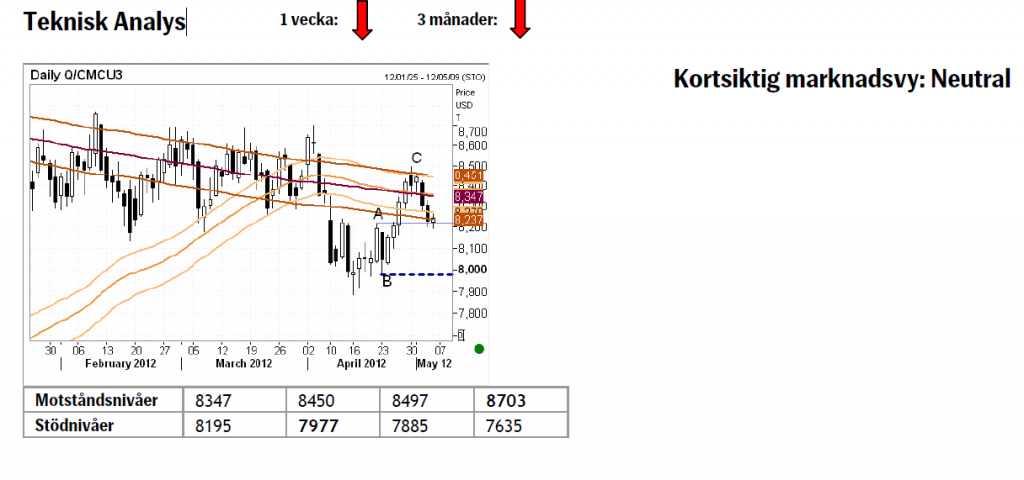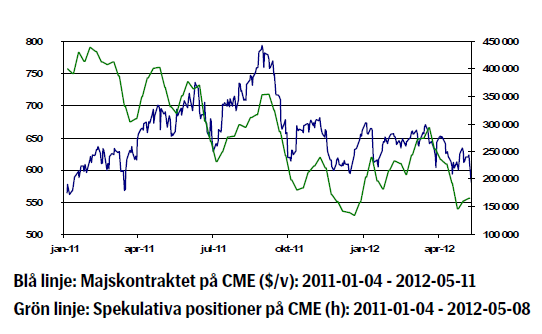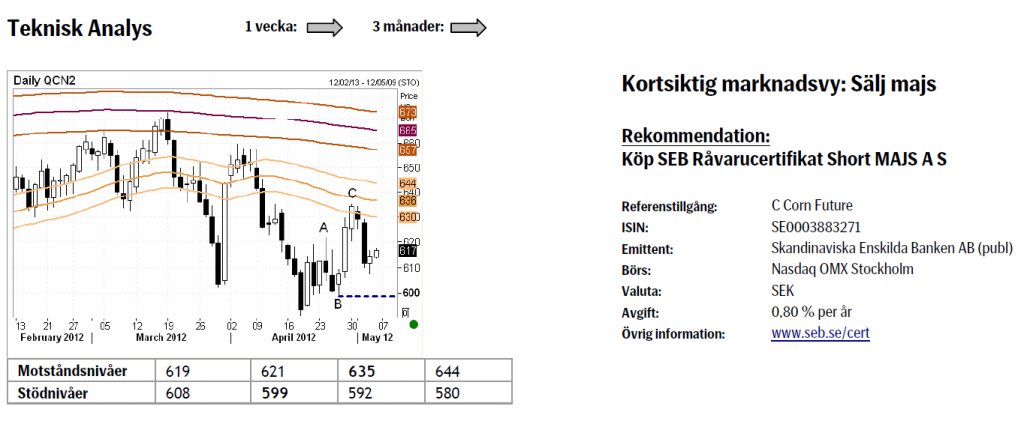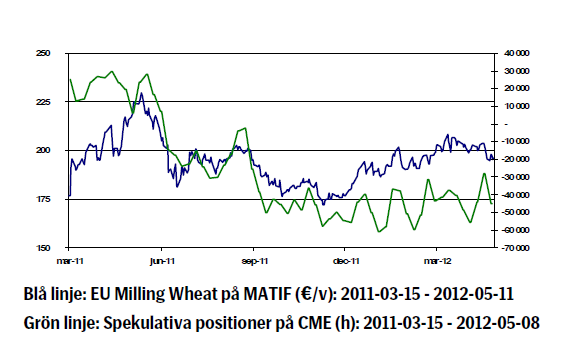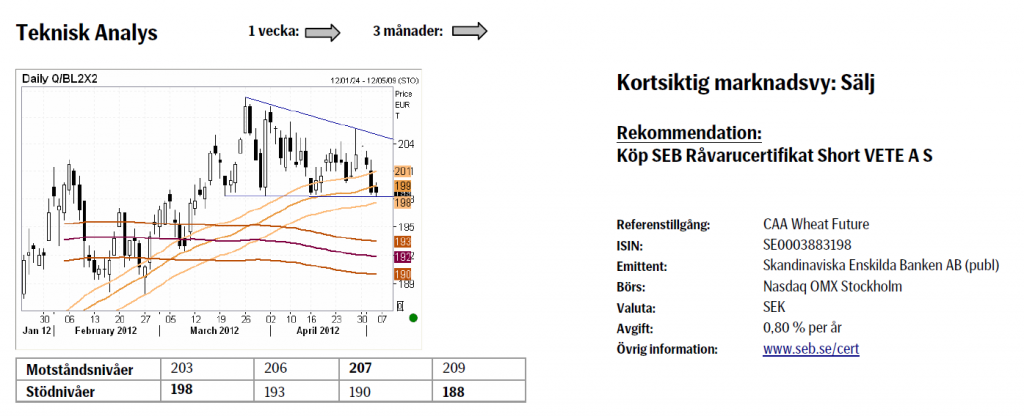Analys
SEB – Råvarukommentarer vecka 20 2012
Sammanfattning: Föregående vecka
 Brett råvaruindex: – 2%
Brett råvaruindex: – 2%
UBS Bloomberg CMCI TR Index- Energi: – 0,34%
UBS Bloomberg CMCI Energy TR Index - Ädelmetaller: – 3,96%
UBS Bloomberg CMCI Precious Metals TR Index - Industrimetaller: – 1,81%
UBS Bloomberg CMCI Industrial Metals TR Index - Jordbruk: – 3,35%
UBS Bloomberg CMCI Agriculture TR Index
Kortsiktig marknadsvy:
- Guld: Neutral/köp
- Olja: Neutral/sälj
- Koppar: Neutral
- Majs: Sälj
- Vete: Sälj
Guld
- Valet i Grekland skapade turbulens. Försöken att bilda regering har misslyckats. Mycket talar för nyval i juni. I slutet av juni är Grekland i behov av nya utbetalningar, men det kräver politiska beslut om nya besparingar för 2013 och 2014.
- Oro över utvecklingen i Grekland och eventuella spridningseffekter har tyngt marknaderna. Spanska 10-åriga obligationer ligger över 6 procent och oron för Spaniens ekonomi är påtaglig. Även i Tyskland ser man nu ett utbrett missnöje med åtstramningar.
- Tyska Bundesbank är villig att acceptera högre tysk inflation i relation till andra euroländers inflation. Detta för att undvika deflation i södra Europa och för att komma till rätta med eurozonens obalanser.
- Guldet föll 3,4 procent och det är uppenbart att guldet inte finner stöd i den systemrisk vi ser i Europa eller i möjligheten till ökad stimulans i form av ökad likviditet. En starkare dollar kan förklara en del av guldets ras men det räcker inte som den enda förklaringen. Vi har sett att utflödet ur guldpositioner skedde i terminsmarknaden medan vi inte såg större utflöden ur fysiska guld ETF: er.
- Korrelationen med andra risktillgångar som råvaror och aktier är hög. Vi tror att vi kan komma att se ytterligare prisfall i denna osäkra makroekonomiska miljö men är benägna att köpa vid större prisfall. Denna vecka är vi neutrala till försiktigt positiva till guldet.
- Teknisk Analys: Fortsatt endast marginella rörelser noterade inom ett redan ganska väl utstakat intervall där under $1620 verkar ”för lågt” och over $1690 ”för högt”. Priset håller sig under ett rullande 55-dagars genomsinittsband. Bandet är svagt i fallande och är på marginalen ett uttryck för visst nedåttryck, men marknaden svarar samtidigt bra på nedställ och i en större positiv bild ser eventuell svaghet ut at vara temporär. Över $1670 & $1695 skulle påvisa efterfrågan och ses som positivt.
Olja
- Oljepriset föll 5,3 Saudiarabiens oljeminister poängterade precis som Opecchefen att man önskar se ett lägre oljepris och att man eventuellt kommer att diskutera en höjning av medlemsländernas produktionskvoter på Opec mötet i juni.
- Saudiarabien kommer att garantera oljeimport till Japan. Japan har starkt behov av oljeimporten eftersom man nu stängt landets alla kärnkraftsverk.
- Även Indien kommer att minska oljeimporten från Iran för att undgå de sanktioner som USA inför i juni. Importen kommer efter ett år att ha minskat med 65 000 fat per dag vilket motsvarar ungefär tre procent av Irans oljeexport.
- Enligt American Petroleum Institute (API) steg råoljelager med 7,8 miljoner fat. Samtidigt bör noteras att lager av oljeprodukter minskade i samma proportion. Även Department of Energy (DOE) visare på onsdagen att råoljelager steg med 3,6 miljoner fat.
- Det dåliga makroekonomiska sentimentet i takt med att situationen i Europa försämras samtidigt som utbudet av olja i marknaden är stort bidrog till oljeprisets fall. Priset verkar ha stabiliserats vid 112 dollar per fat och vi tycker det är svårt att vara positiva på kort sikt.
- Teknisk Analys: Undersidan av 55-dagars bandet (som efter kraftigt nedställ denna vecka är satt i fallande) agerar som dynamisk motstånd (borde inte återtestas under de kommande veckorna). Rörelsen ner är som sagt hård och ska väntas fortsätta för att testa 233-dagars bandet som just nu börjar vid $113.
Koppar
- Kina sänkte i lördags reservkraven för sina största banker med en halv procentenhet till 20 %. Detta var den tredje sänkningen på 6 månader. Denna stimulans väntas öka likviditeten i systemet och kan ge stöd åt kopparpriset. Kinesisk inflationstakt dämpades till 3.4 procent i april från 3.6 procent i mars. Pristrycket är lågt för närvarande och tillväxttakten låg under första kvartalet på den lägsta nivån sedan början av 2009. Kopparpriset föll med 0,8 procent veckan som gick och handlade kort under den viktiga 8000 dollar nivån.
- Kinas handelsstatistik för april var svag. Handelsbalansen steg förvisso men både export och framförallt import föll långt mer än förväntat. Exporten ökade med 4,9 procent jämfört med samma månad året före, väntat var en ökning med 8,5 procent. Importen ökade samtidigt med 0,3 procent, väntat var en ökning med 10,9 procent.
- Industriproduktionen för april steg 9,3 procent jämfört med samma period föregående år. Den var en inbromsning från uppgången om 11,9 procent som noterades i mars, och betydligt under förväntningarna om en uppgång med 12,2 procent.
- Kinas kopparlager föll för femte månaden i rad och föll med 9178 ton till 187449 ton, den lägsta nivån sedan februari. Istället för att importera använder man koppar som finns i lager i landet. Utanför Kina är koppartillgången däremot begränsad och de höga lagernivåerna i Shanghai är en osäkerhetsfaktor.
- Kopparpriset kan fortsätta att pressas eftersom hög kinesisk import tidigare gett stöd åt priset men nu uteblir. Samtidigt kan priset stiga om vi ser att Kina behåller all koppar i landet och den globala marknaden uppvisar en minskad tillgång.
- Teknisk Analys: Rörelsen högre gick något längre än vad som tidigare var trott, men uppsidan av 55-, & 233-dagars ”banden” höll köpare över $8500 nivån borta. Den nuvarande överlappningen under 20 april toppen vid $8218 har ökat sannolikheten att apr/maj rörelsen verkligen är den korrektion vi antagit att den är. Under $$7977 skulle helt bekräfta detta och starkt argumentera för fortsatt rörelse under apr botten vid 7885.
Majs
- Efter att ha handlats över 6 USD/bushel de senaste veckorna föll julikontraktet kraftigt under veckan för att slutligen stänga på 5,81 USD/bushel, en nedgång med 6,33 procent.
- Som vi nämnt i tidigare veckobrev har särskilt den goda efterfrågan från kinesiska boskapsuppfödare agerat stöd den senaste tiden. Torsdagens WASDErapport från det amerikanska jordbruksdepartementet (USDA) fick dock även detta stöd att ge vika.
- I sin rapport justerade USDA upp sin prognos rejält för den amerikanska skörden, där prognosen för landets lagernivå avseende innevarande skördeår justerades upp med över 6 procent jämfört med april månads estimat. Då marknaden förväntade sig en minskning blev följaktligen effekten av rapporten ett rejält prisfall för majsen.
- Fundamentalt ser vi fortsatt ingen anledning att tro på en uppgång för majspriset. Oron i Sydeuropa ökar riskaversionen från investerarkollektivet samtidigt som den goda produktionen minskar intresset från konsumenterna. Vi behåller med detta vår säljrekommendation för majsen.
- Teknisk Analys: Rörelsen upp från apr botten har kommit av sig och börjat se ut som en korrektiv ”3-vågs” rörelse där A-, & C-vågorna nu är symmetriska i storlek och hastighet. Tillbaka under 599 skulle till fullo bekräfta detta och den lätt negativa lutningen på 55-dagars bandet och då argumentera för rörelse under 592, möjligtvis ner mot 580-området.
Vete
- Till skillnad mot sin amerikanska motsvarighet gick vetet i Europa upp något under förra veckan. Detta till stor del baserat på USDA:s jordbruksrapport, i vilken man bedömer att framförallt produktionen i Europa kommer att vara svag under 2012. Det land som kommer att ha störst bortfall är Ukraina, där skörden väntas minska med över 40 procent jämfört med föregående skördeår. Den köldknäpp som drabbade Europa under början av 2012 har fått omfattande konsekvenser och priset på MATIF-vete har sedan årsskiftet gått upp med 1,5 procent. Under samma period har vetepriset i Chicago minskat med nästan 14 procent.
- De senaste veckornas positiva skördeutveckling i USA verkar hålla i sig och det amerikanska jordbruksdepartementet prognostiserar en produktionsökning med 13 procent för landets vintervetesskörd 2012.
- Nu bedömer vi att de största bortfallen avseende den europeiska produktionen är inprisade och ser det som mer troligt att priset kommer att gå ned de kommande veckorna.
- Teknisk Analys: Fallande top Fallande toppar indikerar ett något höjt säljtryck. Skulle stödet just under €200-nivån (& nedsidan på 55-dagars bandet) sluta att attrahera köpare så väntas snabb rörelse tillbaka ner mot stödet vid 233- dagars bandet (som är i fallande) och som börjar vid €193. Över €206 skulle åter minska risken för brott lägre och i stället tas som efterfrågan vid nivåer som tidigare ansågs säljvärda.
[box]SEB Veckobrev Veckans råvarukommentar är producerat av SEB Merchant Banking och publiceras i samarbete och med tillstånd på Råvarumarknaden.se[/box]
Disclaimer
The information in this document has been compiled by SEB Merchant Banking, a division within Skandinaviska Enskilda Banken AB (publ) (“SEB”).
Opinions contained in this report represent the bank’s present opinion only and are subject to change without notice. All information contained in this report has been compiled in good faith from sources believed to be reliable. However, no representation or warranty, expressed or implied, is made with respect to the completeness or accuracy of its contents and the information is not to be relied upon as authoritative. Anyone considering taking actions based upon the content of this document is urged to base his or her investment decisions upon such investigations as he or she deems necessary. This document is being provided as information only, and no specific actions are being solicited as a result of it; to the extent permitted by law, no liability whatsoever is accepted for any direct or consequential loss arising from use of this document or its contents.
About SEB
SEB is a public company incorporated in Stockholm, Sweden, with limited liability. It is a participant at major Nordic and other European Regulated Markets and Multilateral Trading Facilities (as well as some non-European equivalent markets) for trading in financial instruments, such as markets operated by NASDAQ OMX, NYSE Euronext, London Stock Exchange, Deutsche Börse, Swiss Exchanges, Turquoise and Chi-X. SEB is authorized and regulated by Finansinspektionen in Sweden; it is authorized and subject to limited regulation by the Financial Services Authority for the conduct of designated investment business in the UK, and is subject to the provisions of relevant regulators in all other jurisdictions where SEB conducts operations. SEB Merchant Banking. All rights reserved.
Analys
Brent crude ticks higher on tension, but market structure stays soft

Brent crude has climbed roughly USD 1.5-2 per barrel since Friday, yet falling USD 0.3 per barrel this mornig and currently trading near USD 67.25/bbl after yesterday’s climb. While the rally reflects short-term geopolitical tension, price action has been choppy, and crude remains locked in a broader range – caught between supply-side pressure and spot resilience.

Prices have been supported by renewed Ukrainian drone strikes targeting Russian infrastructure. Over the weekend, falling debris triggered a fire at the 20mtpa Kirishi refinery, following last week’s attack on the key Primorsk terminal.
Argus estimates that these attacks have halted ish 300 kbl/d of Russian refining capacity in August and September. While the market impact is limited for now, the action signals Kyiv’s growing willingness to disrupt oil flows – supporting a soft geopolitical floor under prices.
The political environment is shifting: the EU is reportedly considering sanctions on Indian and Chinese firms facilitating Russian crude flows, while the U.S. has so far held back – despite Bessent warning that any action from Washington depends on broader European participation. Senator Graham has also publicly criticized NATO members like Slovakia and Hungary for continuing Russian oil imports.
It’s worth noting that China and India remain the two largest buyers of Russian barrels since the invasion of Ukraine. While New Delhi has been hit with 50% secondary tariffs, Beijing has been spared so far.
Still, the broader supply/demand balance leans bearish. Futures markets reflect this: Brent’s prompt spread (gauge of near-term tightness) has narrowed to the current USD 0.42/bl, down from USD 0.96/bl two months ago, pointing to weakening backwardation.
This aligns with expectations for a record surplus in 2026, largely driven by the faster-than-anticipated return of OPEC+ barrels to market. OPEC+ is gathering in Vienna this week to begin revising member production capacity estimates – setting the stage for new output baselines from 2027. The group aims to agree on how to define “maximum sustainable capacity,” with a proposal expected by year-end.
While the IEA pegs OPEC+ capacity at 47.9 million barrels per day, actual output in August was only 42.4 million barrels per day. Disagreements over data and quota fairness (especially from Iraq and Nigeria) have already delayed this process. Angola even quit the group last year after being assigned a lower target than expected. It also remains unclear whether Russia and Iraq can regain earlier output levels due to infrastructure constraints.
Also, macro remains another key driver this week. A 25bp Fed rate cut is widely expected tomorrow (Wednesday), and commodities in general could benefit a potential cut.
Summing up: Brent crude continues to drift sideways, finding near-term support from geopolitics and refining strength. But with surplus building and market structure softening, the upside may remain capped.
Analys
Volatile but going nowhere. Brent crude circles USD 66 as market weighs surplus vs risk

Brent crude is essentially flat on the week, but after a volatile ride. Prices started Monday near USD 65.5/bl, climbed steadily to a mid-week high of USD 67.8/bl on Wednesday evening, before falling sharply – losing about USD 2/bl during Thursday’s session.

Brent is currently trading around USD 65.8/bl, right back where it began. The volatility reflects the market’s ongoing struggle to balance growing surplus risks against persistent geopolitical uncertainty and resilient refined product margins. Thursday’s slide snapped a three-day rally and came largely in response to a string of bearish signals, most notably from the IEA’s updated short-term outlook.
The IEA now projects record global oversupply in 2026, reinforcing concerns flagged earlier by the U.S. EIA, which already sees inventories building this quarter. The forecast comes just days after OPEC+ confirmed it will continue returning idle barrels to the market in October – albeit at a slower pace of +137,000 bl/d. While modest, the move underscores a steady push to reclaim market share and adds to supply-side pressure into year-end.
Thursday’s price drop also followed geopolitical incidences: Israeli airstrikes reportedly targeted Hamas leadership in Doha, while Russian drones crossed into Polish airspace – events that initially sent crude higher as traders covered short positions.
Yet, sentiment remains broadly cautious. Strong refining margins and low inventories at key pricing hubs like Europe continue to support the downside. Chinese stockpiling of discounted Russian barrels and tightness in refined product markets – especially diesel – are also lending support.
On the demand side, the IEA revised up its 2025 global demand growth forecast by 60,000 bl/d to 740,000 bl/d YoY, while leaving 2026 unchanged at 698,000 bl/d. Interestingly, the agency also signaled that its next long-term report could show global oil demand rising through 2050.
Meanwhile, OPEC offered a contrasting view in its latest Monthly Oil Market Report, maintaining expectations for a supply deficit both this year and next, even as its members raise output. The group kept its demand growth estimates for 2025 and 2026 unchanged at 1.29 million bl/d and 1.38 million bl/d, respectively.
We continue to watch whether the bearish supply outlook will outweigh geopolitical risk, and if Brent can continue to find support above USD 65/bl – a level increasingly seen as a soft floor for OPEC+ policy.
Analys
Waiting for the surplus while we worry about Israel and Qatar

Brent crude makes some gains as Israel’s attack on Hamas in Qatar rattles markets. Brent crude spiked to a high of USD 67.38/b yesterday as Israel made a strike on Hamas in Qatar. But it wasn’t able to hold on to that level and only closed up 0.6% in the end at USD 66.39/b. This morning it is starting on the up with a gain of 0.9% at USD 67/b. Still rattled by Israel’s attack on Hamas in Qatar yesterday. Brent is getting some help on the margin this morning with Asian equities higher and copper gaining half a percent. But the dark cloud of surplus ahead is nonetheless hanging over the market with Brent trading two dollar lower than last Tuesday.

Geopolitical risk premiums in oil rarely lasts long unless actual supply disruption kicks in. While Israel’s attack on Hamas in Qatar is shocking, the geopolitical risk lifting crude oil yesterday and this morning is unlikely to last very long as such geopolitical risk premiums usually do not last long unless real disruption kicks in.
US API data yesterday indicated a US crude and product stock build last week of 3.1 mb. The US API last evening released partial US oil inventory data indicating that US crude stocks rose 1.3 mb and middle distillates rose 1.5 mb while gasoline rose 0.3 mb. In total a bit more than 3 mb increase. US crude and product stocks usually rise around 1 mb per week this time of year. So US commercial crude and product stock rose 2 mb over the past week adjusted for the seasonal norm. Official and complete data are due today at 16:30.
A 2 mb/week seasonally adj. US stock build implies a 1 – 1.4 mb/d global surplus if it is persistent. Assume that if the global oil market is running a surplus then some 20% to 30% of that surplus ends up in US commercial inventories. A 2 mb seasonally adjusted inventory build equals 286 kb/d. Divide by 0.2 to 0.3 and we get an implied global surplus of 950 kb/d to 1430 kb/d. A 2 mb/week seasonally adjusted build in US oil inventories is close to noise unless it is a persistent pattern every week.
US IEA STEO oil report: Robust surplus ahead and Brent averaging USD 51/b in 2026. The US EIA yesterday released its monthly STEO oil report. It projected a large and persistent surplus ahead. It estimates a global surplus of 2.2 m/d from September to December this year. A 2.4 mb/d surplus in Q1-26 and an average surplus for 2026 of 1.6 mb/d resulting in an average Brent crude oil price of USD 51/b next year. And that includes an assumption where OPEC crude oil production only averages 27.8 mb/d in 2026 versus 27.0 mb/d in 2024 and 28.6 mb/d in August.
Brent will feel the bear-pressure once US/OECD stocks starts visible build. In the meanwhile the oil market sits waiting for this projected surplus to materialize in US and OECD inventories. Once they visibly starts to build on a consistent basis, then Brent crude will likely quickly lose altitude. And unless some unforeseen supply disruption kicks in, it is bound to happen.
US IEA STEO September report. In total not much different than it was in January
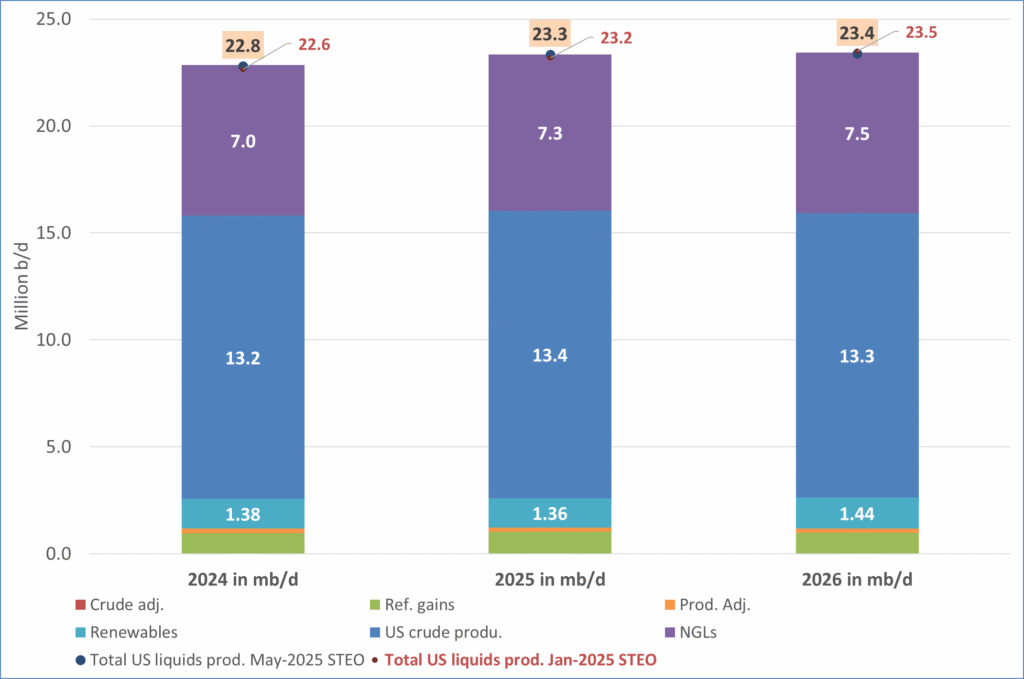
US IEA STEO September report. US crude oil production contracting in 2026, but NGLs still growing. Close to zero net liquids growth in total.
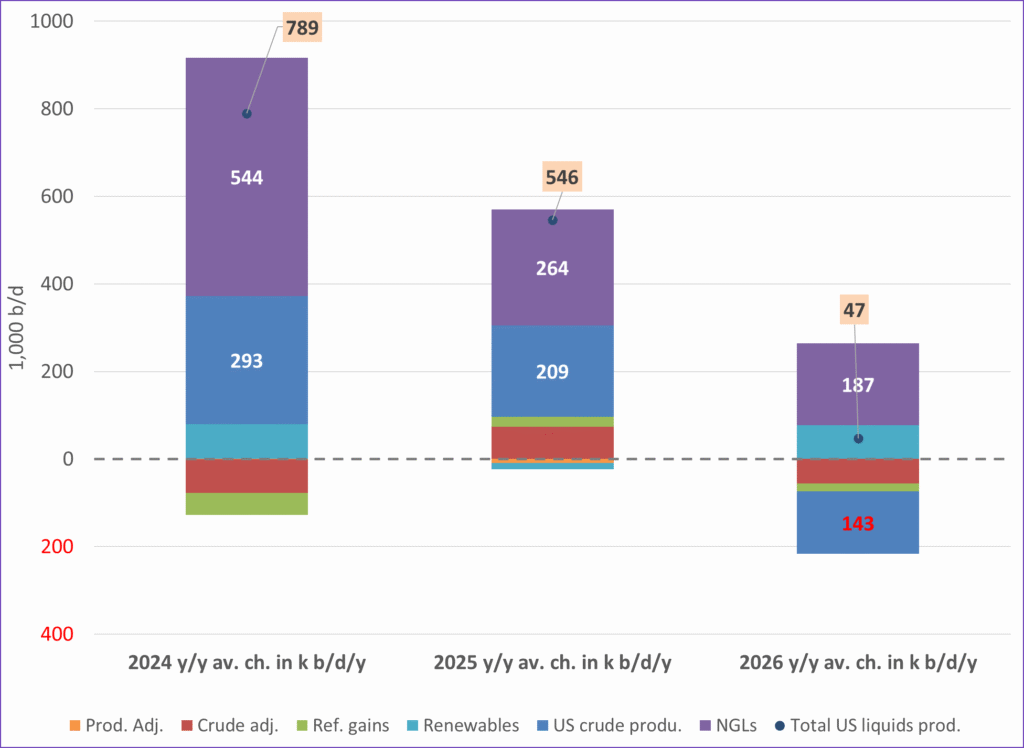
-

 Nyheter4 veckor sedan
Nyheter4 veckor sedanMeta bygger ett AI-datacenter på 5 GW och 2,25 GW gaskraftverk
-
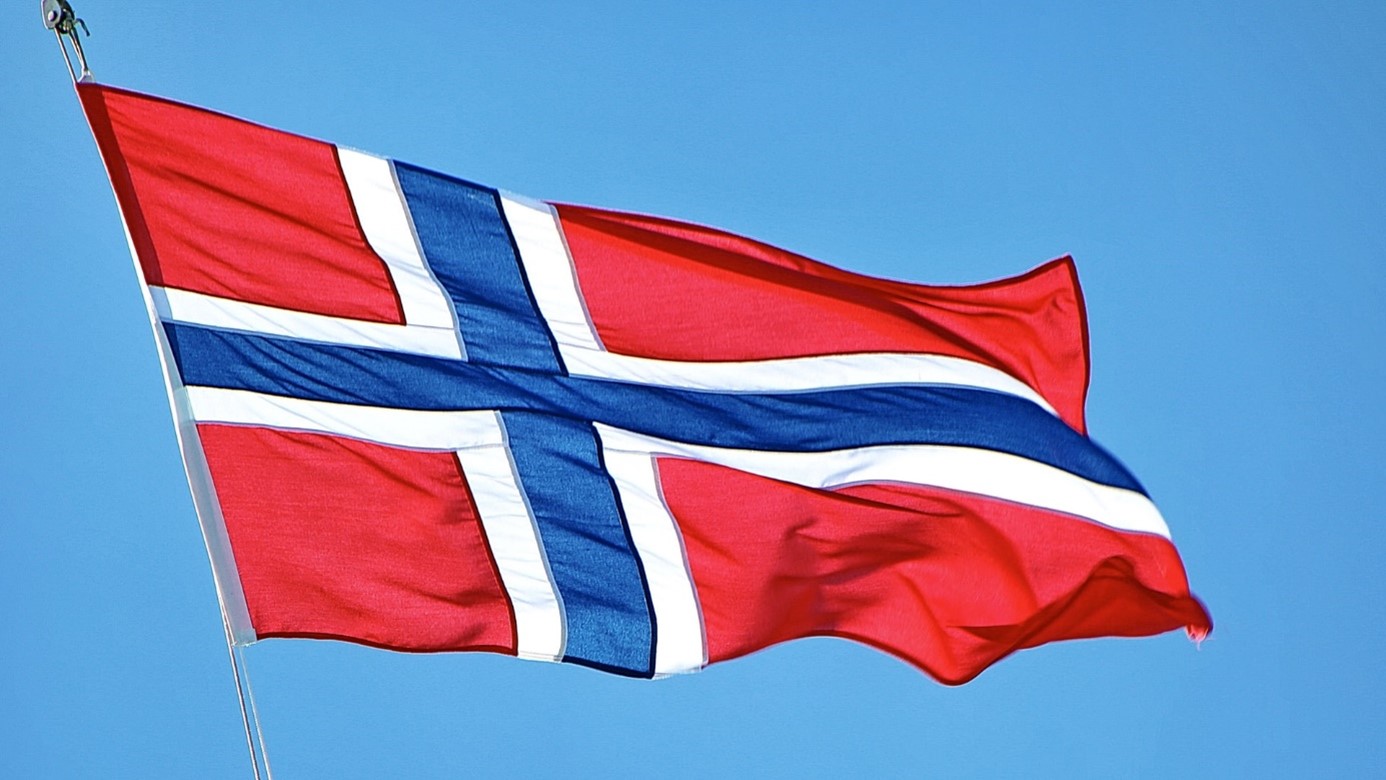
 Nyheter4 veckor sedan
Nyheter4 veckor sedanAker BP gör ett av Norges största oljefynd på ett decennium, stärker resurserna i Yggdrasilområdet
-

 Analys4 veckor sedan
Analys4 veckor sedanBrent sideways on sanctions and peace talks
-

 Nyheter4 veckor sedan
Nyheter4 veckor sedanEtt samtal om koppar, kaffe och spannmål
-

 Nyheter4 veckor sedan
Nyheter4 veckor sedanSommarens torka kan ge högre elpriser i höst
-

 Analys4 veckor sedan
Analys4 veckor sedanBrent edges higher as India–Russia oil trade draws U.S. ire and Powell takes the stage at Jackson Hole
-
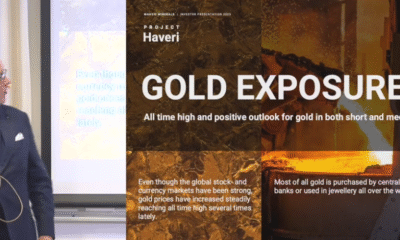
 Nyheter3 veckor sedan
Nyheter3 veckor sedanMahvie Minerals är verksamt i guldrikt område i Finland
-

 Analys3 veckor sedan
Analys3 veckor sedanIncreasing risk that OPEC+ will unwind the last 1.65 mb/d of cuts when they meet on 7 September


